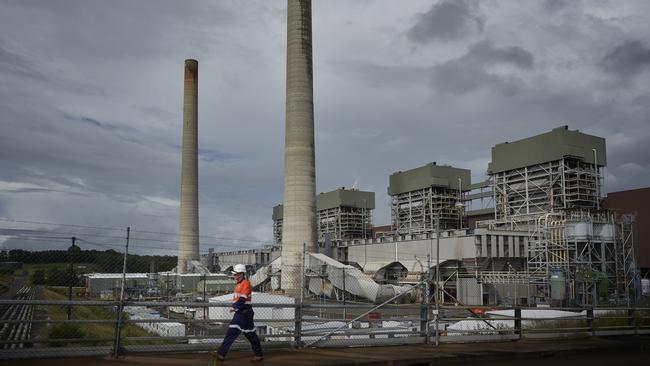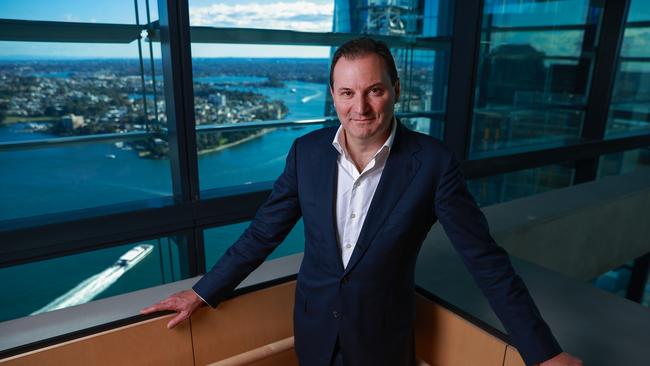Origin Energy chief Frank Calabria weighs up early coal exit as threats of blackouts grow
The power giant had brought forward the closure of Eraring to as early as August 2025 but will monitor market conditions as it considers when to shut it down.
Origin Energy is weighing up the timeline for closing Australia’s largest coal power station amid an increased possibility of blackouts predicted by the market operator in the next few years.
The company earlier this year decided to accelerate by up to seven years a shutdown of the Eraring plant in NSW’s Hunter Valley to August 2025.
However, delays in transmission and Snowy 2.0 have contributed to a power crunch leading experts to question whether Eraring should stay open longer to avoid potential blackouts.
“I think what’s highlighted recently and in reports today is the delay risk highlighted across all states,” Origin chief executive Frank Calabria said in a climate briefing on Wednesday. “And we’ll need to consider that as part of our plans as well. It does highlight the need for a mechanism for the orderly transition.”

Eraring accounts for a quarter of NSW power supply and the Origin chief said the company was constantly weighing up the closure date against a backdrop of its new medium-term target to reduce Scope 1, 2 and 3 emissions intensity by 40 per cent by 2030.
The Australian Energy Market Operator’s electricity statement of opportunities – known as the ESOO – warned in a report released on Wednesday of growing reliability gaps.
“Clearly the (climate) targets in 2030 are based on all four units at Eraring closing and we still are expecting those to be to be closed by that time, but it is something we will have to continue to assess,” Mr Calabria said.
“And I think the reports even today that I’ve briefly glanced from the ESOO is just highlighting the delay risk right now.”
Major energy users said the electricity warning from AEMO underlined the scale of the challenge transitioning power markets to net zero emissions.
“Transitioning our electricity system is going to be hard, expensive and full of risk as has been outlined in the latest ESOO report,” said Energy Users Association of Australia chief executive Andrew Richards. “Consumers could be in for a bumpy ride so we need governments, peak regulatory bodies and the energy industry itself to step up and stay focused on achieving net zero at least cost, not at any cost, while also maintaining system strength and reliability.”

The accelerated transition to renewables and firmed storage could result in increased costs and risks for consumers who will be required to foot the energy transition bill, according to the EUAA.
“It is the clear intention of state and federal energy and climate policy to see the early closure of fossil fuels, replacing it with variable renewable energy resources,” Mr Richards said.
“Therefore, it will be critical that state and federal governments take a leading role in helping to reduce costs and risks for consumers. If energy bills spike, consumer social licence will decline as people begin to lose faith in the transition to a lower-emissions energy system.”

AEMO’s warnings illustrated the urgent need for new transmission to help overcome forecast electricity supply gaps over the next 10 years, Energy Networks Australia said. It has called for fast-tracking critical transmission projects across the east coast.
“The transition to a net-zero energy grid is happening. Solar and wind farms are coming online at pace. However, transmission projects are vital to ensuring that renewable energy gets from where it is generated to where it is needed – into homes and businesses,” ENA chief executive Andrew Dillon said.
As foreshadowed by The Australian on Monday, gaps in reliable supply will emerge across states over the coming years.
There has been a crisis deepening since April, when AEMO warned of an increasing blackout risk due to Eraring closing earlier than expected. The operator has also modelled a potential two-year delay in the Snowy Hydro 2.0 expansion given expectations the timeline for the former government’s energy project faces a deadline blowout, showing worsening forecast reliability in NSW in 2026 and 2027.
Snowy Hydro has yet to officially inform AEMO of any change to the original timeline.
But Snowy chief executive, Paul Broad sensationally quit late last week after The Australian reported that the company’s giant hydro expansion could be hit with $2.2bn in cost overrun claims.
Australia will experience its first cluster of coal generation retirements when at least five plants close this decade.
The shutdown of AGL Energy’s Liddell coal plant in April is not expected to cause any shortfalls given Snowy Hydro’s proposed Kurri Kurri gas plant could replace generation.






To join the conversation, please log in. Don't have an account? Register
Join the conversation, you are commenting as Logout